Carbon nanotubes are structures containing one or more (lattice) layers of graphene. Usually diameters of single-walled carbon nanotubes and multi-walled carbon nanotubes are 0.8 to 2 nm and 5 to 20 nm, respectively, although the diameters of multi-walled carbon nanotubes that reach 100 nm. If you want to know about nanotubes for sale, carbon nanotubes, carbon nanotube sheets for sale, carbon nanotubes properties, cheap carbon nanotubes and so on, read this article.

What can carbon nanotubes be used for?
 At a staggering clip, scientists develop new applications using these nanomaterials. Below are five notable research areas showing the widespread impact of carbon nanotubes:
At a staggering clip, scientists develop new applications using these nanomaterials. Below are five notable research areas showing the widespread impact of carbon nanotubes:
- Carbon nanotubes can help measure terahertz laser light
- Carbon nanotubes for cleaning polluted water
- Strengthening solar energy storage
- Tubes for more efficient electrical transmission lines by ton
- Syringes, electrodes, and bioelectronic noses
Scientists found that by using carbon nanotubes filters, toxins could be more effectively extracted from contaminated water than traditional charcoal filters. Carbon nanotubes have a very large surface area supplying them with a high capacity to hold toxins such as water soluble products. The tubes separated 13 measured Polycyclic Aromatic Hydrocarbons (PAHs) from contaminated water at amounts likely to occur in the area. Before such filters find their way into urban water treatment plants, however, there are still many health and environmental questions to answer.
Pure metallic carbon nanotubes could be the secret to overhauling the electrical power system with more effective transmission lines— but only if they can be manufactured in enormous quantities and reliably. Visible pieces of these densely packed clusters can be cut off using a razor blade and placed on top of a laser power detector to monitor terahertz radiation. Terahertz radiation can penetrate materials such as plastic, clothing, paper and certain biological tissues, making it an attractive candidate for applications such as detection of concealed weapons, inspection of packages and imaging of skin tumours.
How much do nanotubes cost?
Carbon nanotubes are supermaterials which can be more strong than steel and more conductive than copper. The explanation they’re not in every device from batteries to tyres is that these amazing properties only occur in the tiniest, extremely expensive nanotubes. On the market the cheapest carbon nanotubes are costing so much. Carbon nanotubes are basically a layer of compressed graphite, much the way that you slice a tortilla or a cigarette.
The process of rolling this latticework-esque, hexagonal carbon sheet results in the formation of the carbon nanotube, one of science’s most unusual and functional macromolecules.However, as with everything, the cost of these carbon nanotubes is a key determinant of whether or not they will be used, no matter how well they might be used. Looking at the issue of how much nanotubes cost, you have to start with the costs that their use could potentially reduce.
Wholesalers and suppliers of nanotubes in the world
 There are many wholesalers and suppliers of nanotubes all around the world. The best way to buy nanotubes is to buy in bulk from wholeslaers because they always offer the best price. Pure nanotubes and nanotube-polymer composites may be used to make wires for carrying electric current. It has already been shown that the carbon nanotube wires can be used successfully for power or data transmission. Small wires with specific conductivity exceeding copper and aluminum have recently been manufactured; Such cables are the strongest carbon nanotube conductivity, and also the lowest non-metal conductivity.
There are many wholesalers and suppliers of nanotubes all around the world. The best way to buy nanotubes is to buy in bulk from wholeslaers because they always offer the best price. Pure nanotubes and nanotube-polymer composites may be used to make wires for carrying electric current. It has already been shown that the carbon nanotube wires can be used successfully for power or data transmission. Small wires with specific conductivity exceeding copper and aluminum have recently been manufactured; Such cables are the strongest carbon nanotube conductivity, and also the lowest non-metal conductivity.
Recently, it has been shown that the combination of carbon nanotube and copper shows almost a hundred times greater current-carrying ability than mere copper or gold. Significantly, that such a composite’s electrical conductivity is close to pure Cu. Therefore, this composite of Carbon nanotube-copper (CNT-Cu) has the highest observed current-carrying capacity of electric conductors. Thus the CNT-Cu composite can withstand and transport one hundred times higher current compared to metals like copper and gold for a given cross-section of the electrical conductor.











Your comment submitted.